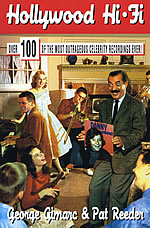 |
|||||||||||||||||

Sour sounds
|
Sour sounds of celebrities 
William Shatner singing "It Was a Very Good Year," a signature song of the renowned Frank Sinatra; Bette Davis with "Just Like a Man" from the 1952 Broadway musical Two's Company; and Regis Philbin on "Toot, Toot, Tootsie (Goodbye)," which ends with him shouting over the fadeout — these are just a few of the "absurd, heartfelt, ego-driven, embarrassing records" that Pat Reeder ('80) and George Gimarc ('80) discovered for their book, Hollywood Hi Fi: Over 100 of the Most Outrageous Celebrity Records Ever.
Reeder and Gimarc discovered their shared interest, and their shared obsession for pop culture, as North Texas students when Reeder worked as a KNTU-FM disc jockey and Gimarc was a production director for the station. "George liked to needle everybody quite a bit, particularly when someone was new and nervous," Reeder recalls. "He came in the booth to do it to me, and I wisecracked him back. From then on, we were friends."
Reeder says some of the singers he and Gimarc discovered for Hollywood Hi Fi believed they were truly musically talented, while some just wanted to make more money and some had their agents "holding guns to their heads." "All of the teen television idols in the 1950s were forced to make records to attract audiences," Reeder says. The list includes Patty Duke, the star of The Patty Duke Show that aired from 1963 to 1966. Duke's managers forced her into the recording studio in 1965 to cash in on the success of her show. Her voice was bolstered by overdubs and an orchestra, Reeder and Gimarc write, but the result was "a whole lot of bad singers singing at once." Another teen television actor, Danny Bonaduce of The Partridge Family, recorded a self-titled album in 1973 as a "personal artistic statement," despite not previously being allowed to sing in any of his series' 96 episodes, Reeder and Gimarc write. Bonaduce, they say, "won't make your ears bleed," but isn't great, either; he sounds "like a typical 13-year-old whose voice is on the edge of changing." Other featured songsters in Hollywood Hi Fi include cast members from The Beverly Hillbillies, Star Trek, Laverne and Shirley and Batman; Johnny Carson and other popular talk show hosts; and box-office stars such as Marlon Brando and Sylvester Stallone.
Reeder says the book tries to answer several mysteries, including why renowned Atlantic Records, which recorded Ray Charles' albums, decided it was a good idea to record an album by Jerry "Beaver Cleaver" Mathers, and why so many actors felt compelled to record with children's choruses and cover the Rolling Stones' "Satisfaction." To be fair, the authors also include a list of talented singers who they say were terrible movie actors — from Tony Bennett to Hank Williams Jr. Excerpts from Hollywood Hi Fi have appeared in several magazines. Reeder and Gimarc also produced a CD with some of the recordings featured in the book, and they're planning an updated edition. "We have so much more material than we had room for in the book," Reeder says. For more excerpts, visit gimarc.com/Hollywood.html.
|
||||